Description of chestnuts with red flowers and their cultivation

Describing chestnuts with red flowers and their cultivation is very important for any gardener. There are pink varieties, horse red and meat red, Brioti, Marginata and other varieties. You need to figure out how to use them when they bloom, how to grow such crops.

Overview of species and best varieties
Horse red chestnut pleases even real aesthetes with its flowers. Such a plant differs from its edible counterpart in its unpretentiousness (including frost resistance), as a result of which it can be safely grown in the middle regions of the country. Fluffy inflorescences can decorate even a large garden area. Important: in a small area, the horse chestnut simply does not fit. The plant reaches a height of 30 m.
In this case, the root system horizontally covers up to 6 m. Horse chestnut produces bell-shaped flowers. They are grouped into inflorescences, similar to a pyramid. These erect inflorescences are surrounded by large foliage.
Even after flowering, the plant retains its spectacular appearance.
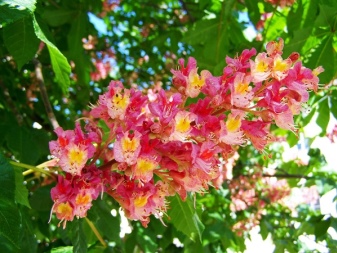
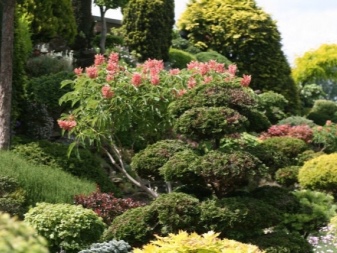
All of its groups are widely used in landscape design. The pink horse chestnut is already a tree that forms a cone-shaped crown of a spreading appearance. Such a plant can rise up to 10 m. The flowers painted in a pink tone are distributed over the inflorescences of an erect type. The five-fingered leaves that surround them turn out to be a very nice visual complement.
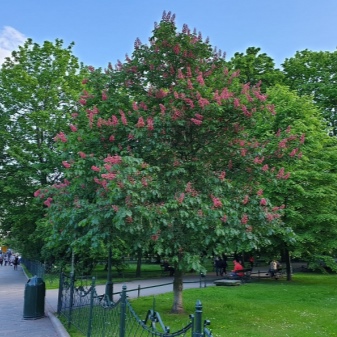

This plant tolerates even heavily clogged air. No wonder it is used to improve the aesthetic properties of parks in areas rich in industrial enterprises. The pink horse chestnut has a subspecies "Brioti". It forms a crown in the form of a ball, sometimes reaching 8 m in width. The height, if conditions are favorable, reaches 15 m.
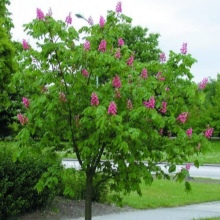
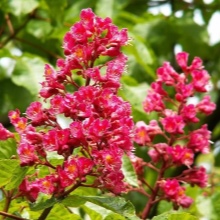
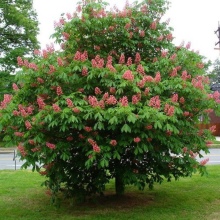
Flowers on "Brioti" are always small. But on the other hand, they are concentrated in impressive inflorescences, reaching 0.2 m. It is this subspecies that is recognized as one of the best chestnuts in terms of decorative parameters. There is another attractive option - meat-red chestnut, the very name of which eloquently describes its essence. This plant tolerates shade, but it develops much better and blooms normally only with sufficient sunlight.
Similar plant:
- rises up to 25 m in height;
- more decorative than the "ordinary" type;
- suitable both as a tapeworm, and as part of an alley, and on a city street;
- in the autumn months it retains its green color for a long time.

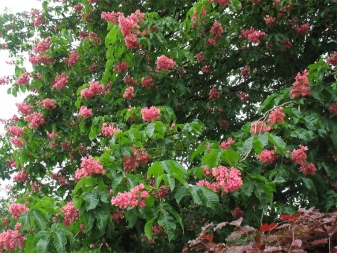
Some experts believe that the Brioti variety refers exactly to the meat-red chestnut. It is very slow in growth. Ruby Red is not colored in any specific way in the fall. This chestnut can be stored dry without any problems, has a dark green color. Initially pyramidal seedlings at 5-7 years of development acquire a rounded top and cast a dense shadow.
Meat-red chestnut will fit into the landscape without any problems. It blooms very vigorously in spring. The thorny pods characteristic of early hybrids have long been defeated. The plant develops normally only in sunny areas.
Special care in winter will not be required, but before sowing, the planting material will have to be stratified.


The variety "Marginata" has pinkish flowers. The foliage is characterized by a yellowish border. Trees grow slowly and reach a height of 10 to 15 m. The crown can have both oval and round appearance.Flowering begins in the first days of June, while the flowers are grouped into cone-shaped panicles, the plant tolerates frosts well.
The dark red pavia chestnut is also highly valued for its external beauty. Experienced gardeners and landscape designers note that it becomes an excellent filling even for a relatively shallow garden. The plant develops quickly, while being easily managed by gardeners. Rounding of the crown is peculiar to it.
The decorativeness of the pavia remains the same throughout the year, regardless of the season.

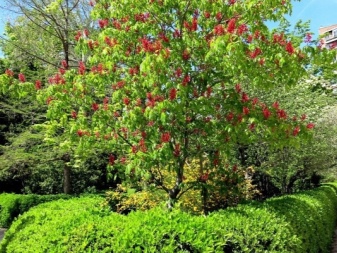
Shrub forms of pavia reach a height of 3-6 m. The highest height of this tree species is 12 m. But if the terrain is characterized by harsh winters, it is not necessary to count on more than 3-4 m. The bark of the pavia has a grayish tint. The trunk is distinguished by visual harmony, growth is relatively slow (the plant reaches its peak height by about 10 years of development).
The top of the pavia is distinguished by its density and visual splendor. The shoots are red in color and tend to sag. The foliage is about half that of traditional chestnuts. For her at the bottom, a light down and a light color of the cutting are characteristic. The characteristic freshness of the color remains even with a short drought.
Pavia is distinguished by paniculate inflorescences. They are noticeably loosened and not as solidly pyramidal as in the classic chestnut. The size of such panicles is 0.15-0.18 m. Bright colors and non-standard color overflows are typical for them, experts even talk about an exotic effect. Inflorescences are collected from densely planted tubular flowers with a bell-shaped pharynx and asymmetry of the petals.
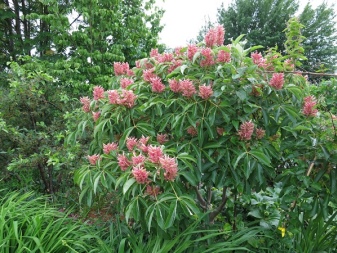
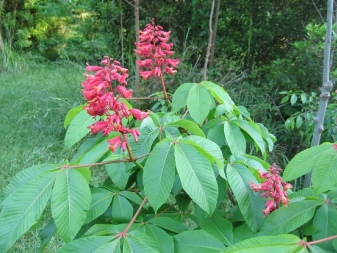
The stamens of the pavia are longer than the petals. The fruit lacks any bristles typical of other horse chestnuts. Several seeds are often hidden inside them. The fruiting period begins in September. Pavia blooms at the very end of spring and at the very beginning of summer, while flowers can be found:
- bright reds;
- light red;
- yellow;
- red-yellow of various varieties (however, when the inflorescence ends its life, it invariably turns yellow).
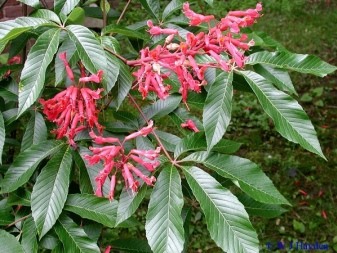
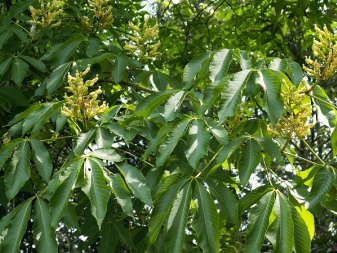
On the basis of the classic pavia, decorative varieties have been bred for a long time. The reason is simple: in nature, this plant is not hardy enough. In addition, due to its high height, it is rather difficult to use it on the site. And finally, breeding subspecies are distinguished by even more pleasant colors. Known:
- semi-cut type, giving a sprawling crown, narrow foliage, powerfully saturated dark red flowers and coldish foliage;
- a dark red group with a wine-scarlet tone;
- undersized plants, allocated by low bushes with open shoots, small light red inflorescences.
The greatest demand among gardeners is the pavia horse chestnut of the Koehnei variety. Loose, prickly-looking inflorescences are typical for him. The flowers have oblong tubes. Outside, they are painted in orange tones, and the corolla has a reddish-pink tint on the inside.
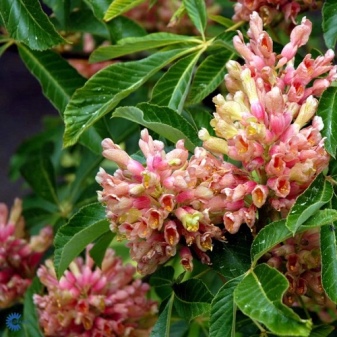
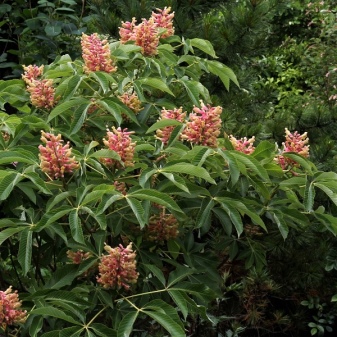
Growing secrets
Landing
The most important point is to get nuts. You can collect them only from the ground, while the fruit is hanging, it is unsuitable for planting. The harvested nuts are carefully checked to ensure that they have an even and smooth surface. Any rough or bumpy areas are unacceptable. Ideally, the fruit should have a dark brown color with a pronounced gloss - this means that it has matured naturally, and has not fallen for any other reason, and is not infected with anything.
Collect chestnuts in as many numbers as possible. Their germination rate is still relatively low. Before planting, this material is kept in moist soil (wet sand is a good substitute). Further, you will certainly need to disinfect the planting material. Heat treatment in the oven is advised to be carried out in advance so that the earth has time to regenerate its important properties.
The reservoir with soil is placed in a cool place. It can be:
- fridge;
- cellar;
- plot in the basement.
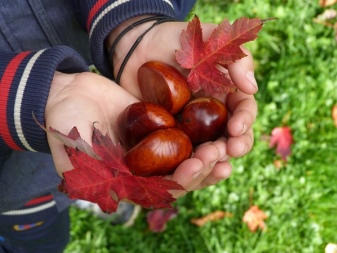
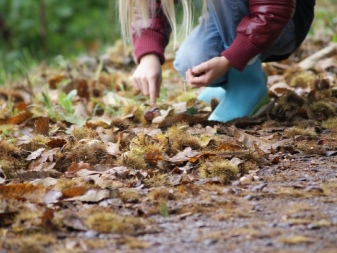
When preparing for spring planting, you will need to keep the seedlings or nuts cold throughout the winter. The soil should be systematically moistened. The soil itself should be prepared in advance. A small amount of dolomite flour is added to the same volumes of humus and forest land. Sometimes sand and moss are simply mixed, nuts are kept in such mixtures for 4-5 months.
In order for the fruits to germinate, their shells are softened before planting. For this, the planting material is placed in clean water. It is changed daily, monitoring the achieved result. It is necessary to achieve the pliability of the shell. Once it is provided, you can plant the nuts in the ground.
No specific choice of location is required. Chestnuts can thrive in a wide variety of conditions. But it is better, of course, to provide optimal insolation and warmth. This speeds up development and allows you to achieve external beauty. To ensure there is one shoot, 6-7 nuts are planted, they are buried in a hole up to 50 mm and a gap between the holes from 150 to 200 mm is left.


Care
Optimal conditions for the development of chestnuts are created on moist, loose loam. In a simple clay area, care is reduced to adding a small amount of sand. If the soil is too loose, then, on the contrary, it is compacted with the addition of clay. To compensate for the depletion of the soil, compost or rotted manure is used, they are diluted with ordinary garden soil. In the autumn months, for better wintering, 0.015 kg of nitroammophos, diluted in 10 liters of water, are laid on 1 m2.
Additionally, as needed:
- loosen the earth;
- weed weeds;
- water the plant.
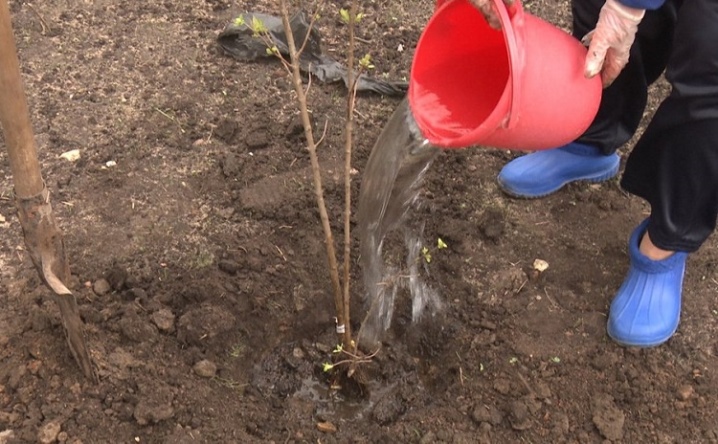
The usual fertilization is done in early spring. One of the options includes:
- urea;
- manure;
- ammonium nitrate;
- phosphorus-potassium fertilizer.
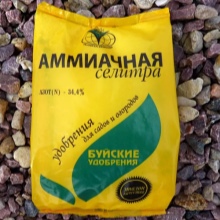

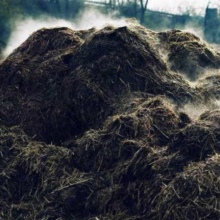
Instead, they often use:
- compost;
- infusions on field grass;
- a mixture of humus and mineral fertilizers.
Before adding top dressing, the chestnut is mulched. For this, sawdust, peat and natural shavings are suitable. Although the plant is cold-resistant, it must be protected from winter for the first 36 months of development. Mulching covered with burlap or non-woven fabric is encouraged.
If the bark is still cracked, use an antiseptic and garden varnish in the spring.
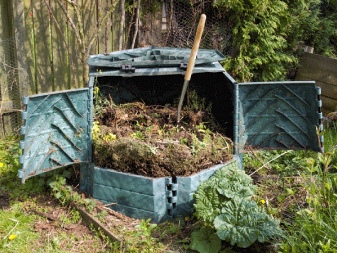
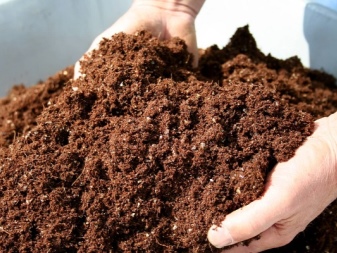
Diseases and pests
Chestnuts can attack fungi, anthracnose and powdery mildew. They are fought with the Bordeaux mixture and other fungicides. In wet weather, fungicidal treatments are often pre-emptive. Along with the pests already known to gardeners - the borer, the Japanese beetle, the bagworm - the previously unknown Balkan moth has now become active.
It is possible to eliminate insects only with the help of branded preparations; to reduce the risk of their occurrence, the foliage is burned every fall.
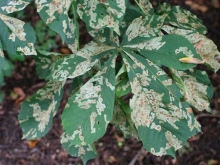
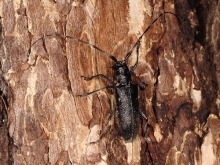
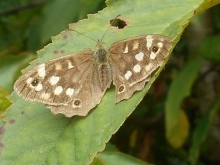
Application
The relatively unpretentious red-flowered chestnut can be used very widely. Most gardeners have only one technique for using it - solo planting. But in the same way, you can grow this crop as:
- part of a multi-row hedge;
- high accent in the palisade;
- high center in a shallow garden;
- part of the alley or imitation of the alley.
Horse chestnut is not only insensitive to air pollution, but also cleans it. Therefore, such a tree can be safely planted near a busy road. On its basis, you can equip a living corner. Chestnut is also good on the playground.
You can also try to apply it in other places, conditions - the result is not so bad either.

You can find out how to plant chestnuts correctly from the video below.



































































Chestnuts sprout beautifully, without any difficulties, but they really need to be kept cold in winter and not dried out. Better to plant in the fall. They often sprout under the trees themselves, and we replant them.
The comment was sent successfully.